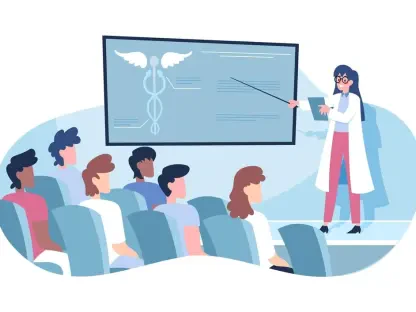In today’s healthcare environment, the advancement of technology has created a double-edged sword scenario. Technological advancements greatly enhance the lives of healthcare staff and patients, making healthcare more accessible and efficient. However, these same advancements also provide cybercriminals with new avenues to breach healthcare systems and steal valuable data. As organizations continue to push forward with digital transformations, the looming threats of security breaches and ransomware attacks cannot be ignored. Finding the right balance between leveraging technology and ensuring robust security measures is crucial. This analysis delves into how healthcare organizations can ensure the security and privacy of patient data while managing large volumes of Electronic Health Records (EHRs), offering valuable insights and solutions drawn from industry experts.
Adoption of Established Cybersecurity Frameworks
Implementing robust cybersecurity frameworks is a foundational step in safeguarding patient data, and frameworks like HITRUST provide a comprehensive set of controls and best practices for enhancing security posture. By adhering to these established standards, organizations not only ensure a high level of security but also compliance with regulatory requirements. Andrew Hines, Chief Technology Officer at Canvas Medical, suggests that beyond adopting these frameworks, healthcare organizations should conduct external audits and validations to ensure that the implemented security measures are effective and current. It is also crucial for core IT vendors, especially those handling EHR and analytics, to adhere to similar security standards to maintain consistent protection across all platforms.
Security Awareness and Identity Protection
One of the most common entry points for cyber threats in healthcare is through compromised individual accounts. Flavio Villanustre, SVP, Technology & Global Information Security Officer at LexisNexis Risk Solutions, emphasizes the importance of security awareness among healthcare staff to combat these threats effectively. Educating employees about the risks of malicious emails and phishing attacks can significantly reduce the likelihood of compromised accounts. Implementing strong multi-factor authentication (MFA) across all systems is another effective measure to protect against unauthorized access by adding an extra layer of security through multiple forms of verification.
Flavio Villanustre also underscores the necessity of robust encryption and mature key management processes to enhance data security. This ensures that even if data is intercepted, it remains unreadable to unauthorized users. Continuous vigilance through attack detection mechanisms further bolsters the organization’s defense against cyber threats. By integrating these security practices into daily operations and ensuring that staff members are well-informed and vigilant, healthcare organizations can create a more secure environment for sensitive patient data.
Advanced Data-Centric Security Techniques
Protecting sensitive health information at the source is essential for maintaining data security, and it can be particularly challenging in large-scale EHR systems. James Rice, Vice President of Solutions Engineering at Protegrity, advocates for advanced data-centric security techniques like tokenization, masking, and anonymization. These techniques ensure that even if a data breach occurs, the patient information remains inaccessible and unusable to unauthorized or malicious users. By integrating data protection directly into the data itself, organizations can maintain usability without compromising security.
Data-centric security techniques like tokenization and encryption can serve as powerful tools in protecting sensitive information. Tokenization replaces sensitive data with non-sensitive equivalents, which can significantly reduce the risk of identity theft and other malicious activities. Encryption, on the other hand, converts data into a different format that can only be read by those with the proper decryption key. This dual-layered approach ensures that patient data remains secure at every stage—whether at rest, in transit, or in use—allowing healthcare providers to continue delivering efficient care while maintaining robust security.
Comprehensive Governance and Integration
A comprehensive approach to security involves combining strong governance policies, advanced technology, and vigilant human oversight. Shay Perera, Co-Founder and CTO at Navina, emphasizes the need for multi-layered defense mechanisms, including encryption, data masking, continuous monitoring, and regular security audits. These measures should be seamlessly integrated into healthcare workflows to avoid impeding care delivery. By implementing robust security protocols and continuously monitoring for potential vulnerabilities, healthcare organizations can ensure that patient data remains secure.
Strong governance policies play a significant role in maintaining data security. These policies ensure that all security measures are consistently applied and followed across the organization. Regular security audits and continuous monitoring help identify and address potential vulnerabilities before they can be exploited by cybercriminals. By incorporating these practices into their operations, healthcare organizations can create a secure environment that is both effective and efficient.
Medical Software Provider Considerations
Selecting the right medical software providers is crucial for maintaining the security of patient data. Thomas Kavukat, Chief Technology Officer at RXNT, outlines several factors that healthcare organizations should consider. One key factor is ensuring that the vendor’s hosting environment is SOC-2 Type II certified, indicating that the vendor has implemented stringent security controls to protect sensitive data. Organizations should also determine whether the software is cloud-based or server-based and verify that the vendor maintains proper certifications and compliance.
Key security measures such as encryption, multi-factor authentication, backups and recovery systems, and regular security assessments are essential for maintaining a secure environment. When choosing a medical software provider, it is important to perform due diligence to ensure that the vendor adheres to the highest security standards. By carefully selecting software providers and ensuring that they maintain proper certifications and compliance, healthcare organizations can ensure that patient data remains secure and protected.
Health Information Management Practices
Robust health information management practices play a crucial role in maintaining data accuracy and compliance with regulations like HIPAA. Saji Rajasekharan, Chief Technology Officer at Experity, advocates for seamless integration between Electronic Medical Records (EMR), Practice Management (PM), and health information management systems. This integration ensures that patient data is accurately recorded, stored, and accessed in a secure manner. By implementing strong health information management practices, organizations can better protect patient data.
Regular updates and staff training are essential components of effective health information management. Ensuring that systems are constantly updated reduces the risk of vulnerabilities that can be exploited by cybercriminals. Staff training helps employees understand the importance of data security best practices and how to implement them in their daily routines. By investing in continuous education and system updates, healthcare organizations can create a culture of security that protects patient information more effectively.
Vendor Certification and Compliance
Ensuring that EHR systems meet strict security standards is crucial for maintaining patient data security and privacy. Jitin Asnaani, Chief Product Officer at Rhapsody, advocates for the use of certified EHR systems that include strong access controls, encryption, audit logging, and robust user access measures. Organizations should thoroughly assess the security practices of software vendors and verify their compliance with industry standards to ensure the highest level of protection.
Using certified EHR systems helps organizations maintain a high level of security and compliance with regulatory requirements. Strong access controls prevent unauthorized access to sensitive data, while encryption ensures that data remains unreadable to unauthorized users. Audit logging provides a trail of all access and modification events, which is crucial for identifying and addressing potential security breaches. By selecting vendors who adhere to industry standards and regularly updating their systems, healthcare organizations can ensure that their EHR systems remain secure.
Main Findings
In summary, healthcare organizations can ensure the security and privacy of patient data while managing large volumes of EHRs through a combination of strategic frameworks, advanced technologies, and proactive governance policies. Adoption of robust cybersecurity frameworks like HITRUST ensures a strong security foundation. Enforcing multi-factor authentication and robust access controls significantly reduces the risk of unauthorized access and compromised identities. Advanced data-centric security techniques like tokenization, masking, and encryption protect sensitive data comprehensively.
A comprehensive governance approach that includes strong policies, regular security audits, and continuous monitoring is crucial. Integration of security measures into workflows ensures that security protocols do not hinder the efficiency of care delivery. Ensuring vendors maintain proper certifications and compliance, as well as conducting due diligence on their security practices, further strengthens the security posture. Ongoing staff training and awareness remain critical components in maintaining a secure environment.
Conclusion
Ensuring the security and privacy of patient data while managing large volumes of EHRs requires a multifaceted approach that integrates advanced security techniques, strong governance policies, and continuous vigilance. By adopting established cybersecurity frameworks, enforcing robust access controls, and embedding security measures into workflows, healthcare organizations can create a secure environment that protects patient data and supports efficient care delivery. Regular audits, staff training, and verification of vendor compliance further strengthen the security posture. This detailed and comprehensive analysis provides a cohesive narrative that captures the key points and offers valuable guidance for healthcare organizations navigating the challenges of EHR security and privacy.









